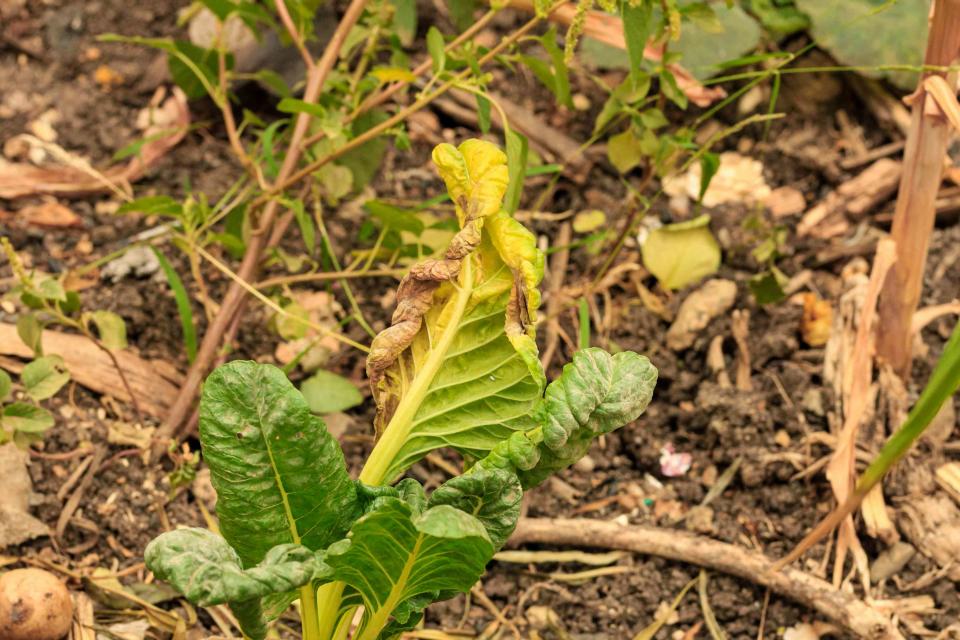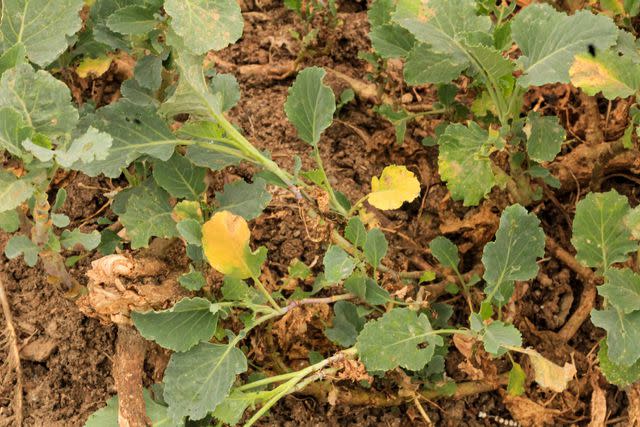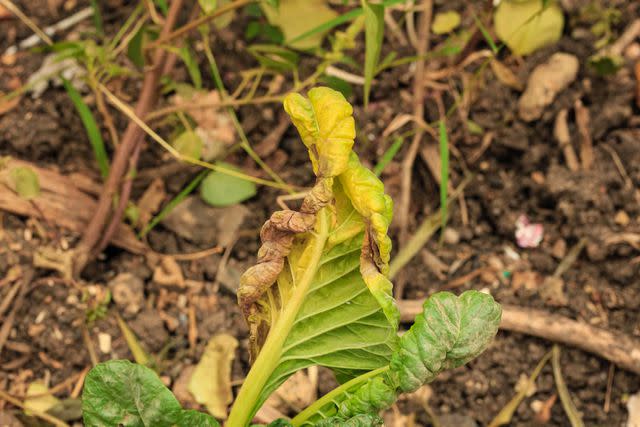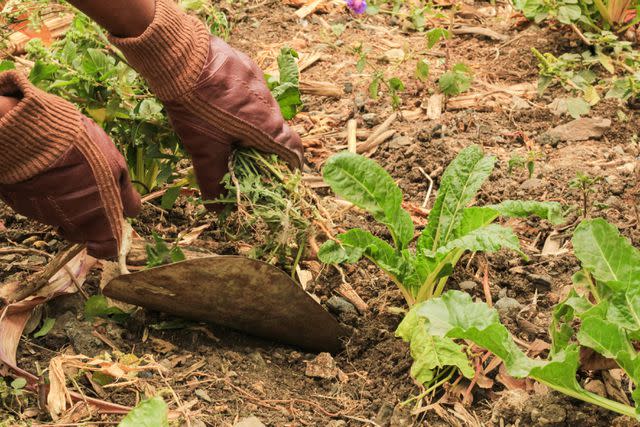Aster Yellows: Symptoms, Treatment, and Prevention
This disease can affect many different garden plants—here's how to treat it

The Spruce / K. Dave
Reviewed by Mary Marlowe Leverette
The name "aster yellows" is misleading because this disease affects more than 300 plant species beyond asters. The disease's namesake is the aster leafhopper, an insect that spreads the aster yellows pathogen.
The bad news is that there is no treatment once a plant is infected. But there are several things you can do to prevent aster yellows from spreading.
Key Facts
Appearance: Aster yellows looks like the leaves on the plant are stunted or discolored from pale green to yellow or white.
Causes: Aster yellows is caused by phytoplasma bacteria that can affect up to 300 species of plants.
Diagnosis and treatment: Aster yellows has no cure, so prompt diagnosis and removal are essential to prevent spreading to other plants.
Transmission: Aster yellows is spread by the aster leafhopper insect as they feed on plant sap and pass it on from one plant to the next.
What Is Aster Yellows Disease?
Aster yellows is caused by a mycoplasma-like bacteria that can live only within the veins of a plant or within the aster leafhopper (Macrosteles quadrilineatus).
It causes plant discoloration, stunted growth, flowers that stay green, and malforms vegetables, making them taste bitter, like garlic, carrots, and onions. It also hurts flowers like asters, coneflowers, marigolds, chrysanthemums, petunias, and snapdragons.
Symptoms of Aster Yellows
Depending on the plant species, aster yellows symptoms are different. The entire plant can show signs because the pathogen moves through the plant, from the roots to the flowers.
Stunted growth: In infected plants, you will notice stunted growth and numerous odd-looking secondary shoots. The leaves are smaller and more narrow than those on a healthy plant, and they are curled or twisted. The leaves show signs of chlorosis—the leaves are yellow while the veins stay green. The foliage is pale, yellowish, white, or, at a later stage, red or purple.
Malformed, small flowers: Often developing funky-looking leafy parts instead of flowers. Purple coneflower may generate a second clustered flowerhead, and marigolds may have leafy, green flowers. The flowers are off-colored, dull, and nowhere near their vibrant colors. The plants don’t produce seeds; if they do, they are sterile.
Poor vegetable or fruit quality: In infected carrots, the tops have a bunch of red or yellow stunted leaves. Instead of a healthy, thick root, there is only a thin taproot with many small, white, hairy roots. They often taste bitter. Similarly, onion tops are twisted and yellow, with leaves growing into thick, stunted bunches. In lettuce, telltale signs of aster yellows are curled inner leaves. The head never fully develops. The leaves also have pink or tan spots.
Plants Affected by Aster Yellows
Members of the aster family (Asteraceae) are most commonly affected by aster yellows. These include aster, calendula, chrysanthemum, coreopsis, cosmos, daisy, gaillardia, marigold, purple coneflower, zinnia, and more than 40 other plant families.
Flowers susceptible to the disease are anemone, delphinium, periwinkle, petunia, snapdragon, and veronica. Many garden crops that can be infected include broccoli, cabbage, cauliflower, carrot, lettuce, onion, potato, pumpkin, spinach, strawberry, and tomato.
Weeds—dandelion, cinquefoil, horseweed, ragweed, thistle, wild carrot, and wild lettuce—getting the disease might not sound problematic. It is a problem because aster yellows in weeds spread to desirable plants.

The Spruce / K. Dave

The Spruce / K. Dave
How Aster Yellows Spreads
The aster leafhopper spreads the pathogen in aster yellow. When it feeds on a plant infected with aster yellows, it sucks up some of the aster yellows mycoplasma with the plant sap.
In about two weeks, the leafhopper develops a salivary gland infection, transmitting the mycoplasma to any of the plants it's feeding on. The mycoplasma remains in the leafhopper during its entire life (it can live up to 90 days) without causing harm to the insect itself.
Aster leafhopper is native to North America and is nearly everywhere, but it is most common in the central region of the continent—the Midwest and Great Plains regions. The aster leafhopper does not survive in climates with subzero winters. In the spring, aster leafhoppers move north from their overwintering locations along the Gulf of Mexico.
The occurrence of the aster yellows is directly connected to the aster leafhopper population in any given year. Cool, wet summers create favorable conditions for the leafhopper and the spread of the disease, whereas aster yellows are less common in hot, dry weather.
Aster Yellows Control
After the aster leafhopper has infected a plant, symptoms will appear within ten to 40 days. There is no cure, treatment, pesticide, or insecticide to control aster yellows.
That’s why early diagnosis is crucial. Promptly remove any infected plants from your garden and dispose of them so no more aster leafhoppers can feed on them and spread the disease further.
The aster yellows pathogen won’t survive on a dead plant, so that you may compost infected plants.
Aster Yellows Prevention
The tricky thing with aster yellows is that it does not kill a plant. You might be inclined to leave an infected plant in your garden, especially if it’s a perennial. Don’t—the pathogen can survive in perennial plants from one season to the next, and infected perennials can transmit aster yellows to other plants for many years. All it takes is an aster leafhopper feeding on that plant. Therefore, you should remove any perennials—landscape plants and weeds—from your garden.
Mechanical barriers can be used to protect plants from the aster leafhopper. Light-colored or reflective mulches or foils disorient the insects so they won’t feed on the plants. Floating row covers, mesh fabrics, or fine wire mesh may protect vegetables.
Planting only healthy cuttings and plants from a reliable source in your garden is the first step to preventing aster yellows. If you have aster yellows, it’s a good idea to select plants that are less susceptible to the disease, such as cockscomb, geranium, impatiens, nicotiana, salvia, or verbena.
Weeding, especially plantain (a perennial weed) and dandelion, which are prime carriers of the aster yellows pathogen, also helps to control the disease.

The Spruce / K. Dave
Read the original article on The Spruce.

